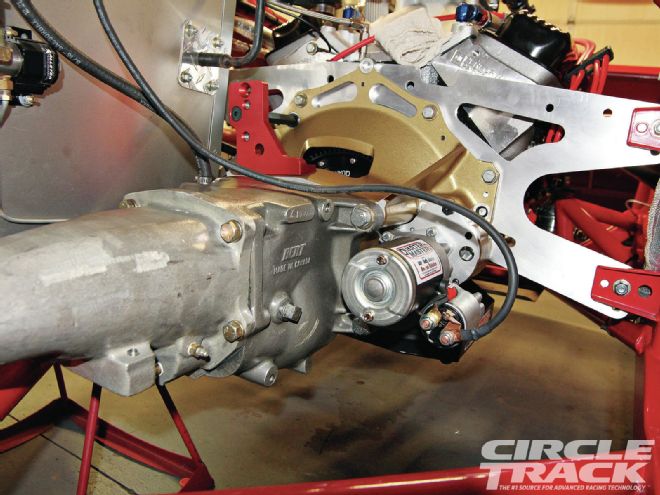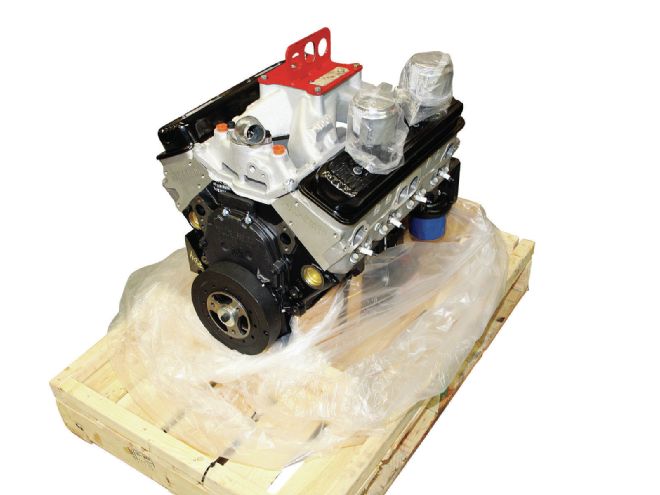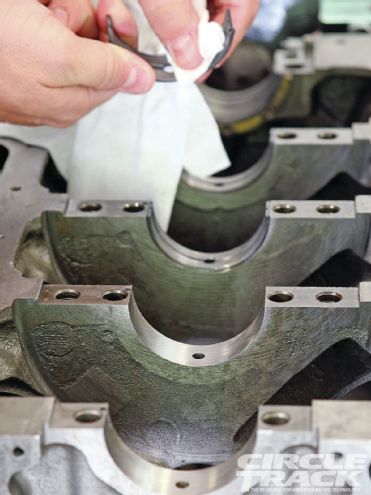
One of the common misconceptions for crate racing is all you have to do is go out and buy a crate motor, bolt it up, and you’re ready to go racing on the cheap. Unfortunately, unless you get lucky enough to have all the right parts and pieces that bolt right up, there’s a bit more to it than that.
 Here's the new Chevy "604" crate engine Dirt Late Model racer Chris Hargett purchased when his usual class, the Limited Late Models, began being phased out in favor of the crates. Successfully racing in the crate class involves
more than simply dropping in the motor and hitting the track, and we're going to monitor Hargett's progress as he makes the transition to see what tips we can pass along to you.
Here's the new Chevy "604" crate engine Dirt Late Model racer Chris Hargett purchased when his usual class, the Limited Late Models, began being phased out in favor of the crates. Successfully racing in the crate class involves
more than simply dropping in the motor and hitting the track, and we're going to monitor Hargett's progress as he makes the transition to see what tips we can pass along to you.
These days, crate racing has become a very competitive business. Even if you’re racing a box-stock crate motor, there’s a lot you can do to separate yourself from the pack. Because of its limited horsepower, and the fact that everybody is racing the same engine, crate racing has become a game of momentum. The racers that are winning the most are doing a better job of maintaining speed as they roll through the corners so that the exit speed is also increased. That’s a traction and chassis setup issue. On the engine side of things, the winners are constantly finding ways to limit the unnecessary friction and horsepower losses on the power-limited crate engines.
Because of the unique qualities of the most popular crate racing engines—the Chevrolet 602 and 604 engines are easily the leaders of the pack in the crate racing world—smart racers and component manufacturers have developed hardware specifically to work with the crates. Lightweight, low-drag components help eliminate friction so more of the horsepower generated makes it to the rear wheels. For example, Jones Racing Products has produced a front-drive kit specifically for the 604 crate engine. And because they know where this engine redlines, Jones was able to size the water pump pulley perfectly so that the pump spins at the optimum speed to provide good coolant flow through the engine and radiator without spinning the pump too fast which just burns horsepower.
On the other end of the engine, Quarter Master has recently made available a bellhousing/starter/ flywheel kit that’s designed with the same high quality as the kits specified for the Super Late Models but this kit utilizes a small flywheel combined with a high-torque reverse mount starter to minimize rotating weight. This reduction in weight can help the engine spin up faster and accelerate out of the turns just a bit more quickly than the competition.
 If you’re running an asphalt chassis with standard motor mounts, then mounting up the 604 crate is no issue. Most Dirt Late Model chassis utilize a midplate sandwiched between the motor and the bellhousing for mounting the engine to the chassis. The Quarter Master kit is designed to work with a 0.250-inch-thick midplate and is predrilled and mounts up no problem.
If you’re running an asphalt chassis with standard motor mounts, then mounting up the 604 crate is no issue. Most Dirt Late Model chassis utilize a midplate sandwiched between the motor and the bellhousing for mounting the engine to the chassis. The Quarter Master kit is designed to work with a 0.250-inch-thick midplate and is predrilled and mounts up no problem.
That’s the purpose of this two-part series. Giving yourself the best chance when going crate racing means taking a good, hard look at the entire drivetrain—not simply dropping in your new crate motor and going racing. Recently, we looked at installing a low drag rearend in a Dirt Late Model (in the Aug. and Sept. ’11 issues of Circle Track), this time around we’ll spend a couple of issues looking at components closer to the engine.
Up first is Quarter Master’s Clutchless Bellhousing Kit, which is a perfect first for Dirt Late Model crate racers. Next month, we’ll outfit the rest of our new Chevy 604 crate with a front-drive kit from Jones Racing Products, prime the pumps with a trick fuel pump and regulator setup from CV Products, and wire everything up with a complete ignition system from MSD.
Besides a straight-up bellhousing and clutch install, we’ve included a few tricks that should make your life in the pits a little easier if—heaven forbid—you have to pull your engine for some reason. We’re working with a Dirt Late Model, but much of what we’re discussing here will work with any crate class (especially if you’re racing a Bert/Brinn-style transmission). So check out the first of our two-part installment series on outfitting your crate motor and be sure to check back in next month.